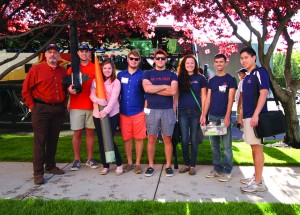 The Auburn University Rocket Team, consisting of eight engineering students and two advisers, is taking to heart Def Leppard’s lyrics ‘We gotta fly’ from its 1987 hit song “Rocket.” The team competed in the NASA University Student Launch Initiative (USLI) in Salt Lake City in May as one of 37 teams from across the country, Canada and Puerto Rico to take part in this research-based, competitive exploration project.
The Auburn University Rocket Team, consisting of eight engineering students and two advisers, is taking to heart Def Leppard’s lyrics ‘We gotta fly’ from its 1987 hit song “Rocket.” The team competed in the NASA University Student Launch Initiative (USLI) in Salt Lake City in May as one of 37 teams from across the country, Canada and Puerto Rico to take part in this research-based, competitive exploration project.
The trip to Salt Lake City for the rocket team, also known as Team Nova, marked the first year it qualified for the competition in the past four years.
“Competing at such a high level of competition has been a one-of-a-kind experience for our students,” said Joseph Majdalani, Auburn Alumni Engineering Council endowed professor and chair of aerospace engineering. “I am proud of the team for exceeding expectations and working as hard as they did to qualify right up to the last minute.”
Team Nova began its rocket journey in December by submitting a detailed proposal to NASA’s USLI. After making it through the initial proposal round, the team had to pass preliminary design, critical design, flight readiness and launch awareness reviews. Auburn’s proposal, which totaled nearly 350 pages, followed the NASA engineering design lifecycle standards consistent with NASA’s Human Exploration and Operations workforce.
During the design phase, the team built the rocket around the motor, aerodynamics, payload deployment and payload size. After the design was finalized, the group agreed the optimal material to use for the rocket parts would be fiberglass for the nose cone, body and fins. When the rocket was completed, it measured 108 inches in length, and five inches in diameter, with a mass of 55.2 pounds.
“Getting to help design and build a nine-foot rocket with Team Nova was one of the greatest experiences I’ve had,” said team member Bethany Bittinger, a junior in aerospace engineering. “From figuring out the best material to use for construction to making vehicle design changes, and determining our three payloads, we have all learned countless lessons. After writing design reports and working on fabrication for months, it was amazing to see our ideas come to fruition and launch our rocket in Utah,” Bittinger said.
The culminating effort represents eight months of design, outreach and finally building the pre-impregnated carbon fiber rocket to launch 15,500 feet into the air in Salt Lake City. The team was judged on how close the rocket came to its target height. Nova competed among several universities, including Vanderbilt, Northwestern, Purdue and Cornell. Prior to the event, students participated in practice launches as part of the Georgia Rockets in the Sky program which allowed teams to evaluate how far each rocket would launch and make needed adjustments to the scientific payload prior to the student launch. In addition, the rocket was tested at Phoenix Missile Works in Sylacauga, Ala., and Southeast Alabama Rocket Society in Samson, Ala.
While in Salt Lake City, the team had to evaluate payload and flight data during a post launch assessment review and complete an initial and final launch readiness review. By the time all of the final reviews had been performed by judges, and teams advanced to the rocket launch round, Auburn was one of only 16 teams to qualify.
“Our team has learned so much throughout this process,” said Luke Humphreys, a senior in aerospace engineering and student team leader. “We learned how to work together more efficiently to solve challenges, especially those that we faced right before the rocket launch,” he said.
Young rocketeers 
Auburn’s Team Nova also completed an outreach component of the competition. With guidance and supervision from Rob Kulick, coordinator of student services in the Department of Aerospace Engineering, the group developed a rocket curriculum for more than 600 Drake Middle School seventh graders (exceeding the USLI requirement of 200 students). In April, members of the team taught the students about gravity and its force on the human body during their life science class. After learning about gravity’s impact, the middle school students built their own rocket with instruction from the Auburn rocket team. Rocket materials were provided by Auburn University’s Department of Aerospace Engineering through a grant from NASA.
“Most seventh graders are at the stage where they are just beginning to think about their future and career,” said Kulick. “It was our goal to demonstrate how science can be interesting and impact the world through a rocket-based curriculum. The amount of time and energy the team spent putting together the curriculum paid off with the seventh graders’ positive reactions,” he said.
The grand finale ended with students launching their homemade rockets in an open field near the back of the school.
“The students were curious and excited about the curriculum and asked a lot of good questions,” said A.J. Pollard, a junior in aerospace engineering and team member. “Our goal was to encourage them to go into a math, science or engineering-related field and I hope they will continue to stay engaged.”